by Admin Mediterra | Sep 26, 2020 | Synchronization
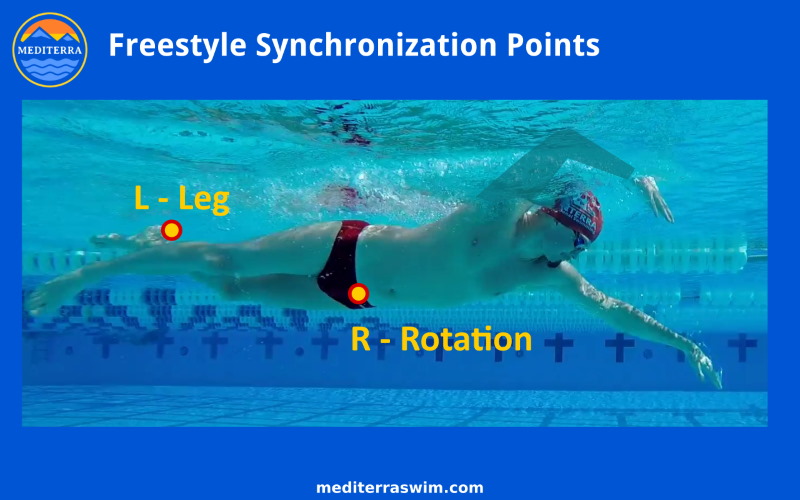
You can begin to synchronize the leg press with the rotation once you have the arms synchronized in front, because the leg motion is ultimately going to connect to the arms through the torso. Without that timing in front, the legs will have a hard time finding the 2BP rhythm in the rear. But before you connect those distant points, you will first work on connecting the press of the leg with the rotation.
Before the rotation, you may appreciate how the foot has been positioned in the Counter-Balanced Leg Position, poised, ready to press. Notice in the image above how the Streamline side of the body is down, while the Streamline side heel is up, near the surface. The raised position of the streamline side leg and the downward pointing leg of the other side are counter-balancing the body’s rotated position in front. The leg is ready to push downward so that the Streamline side of the body can rotate upward. The press of the leg offers support, it offers leverage to help the rotation go with a bit more power.
As with the fine tuning of the arm overlap, the timing of the leg has a little room for adjustment according to the tempo of the stroke. At slower tempos, the leg will press a moment after the torso has begun to rotate. At slower tempos, the press of the leg feels like it is helping to finish the rotation. At very fast tempos, the leg will press at the same moment the torso begins to rotate. In this case, it may feel like the press of the leg is helping to start the torso rotation. This is very helpful when working at sprinting tempos, where it is harder to keep the torso rotating back and forth to keep up with the demanding tempo.
Instructions

Step 1: Down-Up Leg-Torso Connection
Use the press of the leg to help rotate the same side of the torso upward toward the surface. The leg is moving down and the side is moving up in response. This is the simple down-up connection. Notice in the image above, how the foot is now down and the hip of the same side is on its way up toward the surface.
And, it will be helpful to practice working just one leg, one side repetitiously. Remember that the 2BP is just one foot pressing in one arcing path. The other foot is not pulling, it is just drifting back in the opposite direction. So practice working just one leg at a time, over and over again, while the other practices holding pointed toes.
Step 2: Use Hip Torque
As instructed in our Intro to the 2 Beat Leg Press, now notice how the turn of the ankle corresponds to the turn of the rotation. Rather than bending the knee and pushing with the thigh, keep the knee fairly straight (allow the slightest flex) and twist your ankle in order to activate torque in the hip socket. Create that ‘Crescent Moon’ pathway with your toes. This is the more effective way to direct the press of the leg. By arcing the toes from ‘pigeon toe’ inward to ‘toes outward’ this action torques the hip joint, urging the whole torso to rotate with it. This is how you genuinely generate a ‘hip-driven’ kick. Use the torque of the muscles surrounding the hip joint, rather than pressing downward with the thigh muscles as you would with a normal flutter kick.
Review the 2BP drill videos in the Knowledge Base to tune up how you perform the kick action.
Step 3: Refine The Timing Per Tempo
Since each swimmer’s functional tempo range is a bit different from any other’s, you will need to do some experimenting to set the best timing of the press to match each tempo zone (slow, medium, brisk) you work in.
For your slower comfortable tempos, let the press of the leg lag slightly behind the start of the rotation.
For your fastest tempos, let the press of the leg start immediately with the start of the rotation.
And for your medium tempos, let the press of the leg start somewhere in between.
Step 4: Refine The Pressure
It is tempting to kick abruptly or ‘snap’ the kick, but resist this. When you understand how the press of the leg is suppose to enhance the rotation, then you need to slow down that press and make the pressure steady and continuous as possible during the time taken by the rotation. Try to make the press of the leg last longer, to support the rotation longer.
Match the rate of speed of the leg press to the rate of speed of the rotation. It won’t be exact – the leg will certainly move a bit faster – but aim for this match as much as possible. If the leg snaps too quickly, it sends a wave of force that can’t be fully absorbed into the rotation, and this becomes another form of ‘power leakage’.
by Admin Mediterra | Sep 24, 2020 | Synchronization
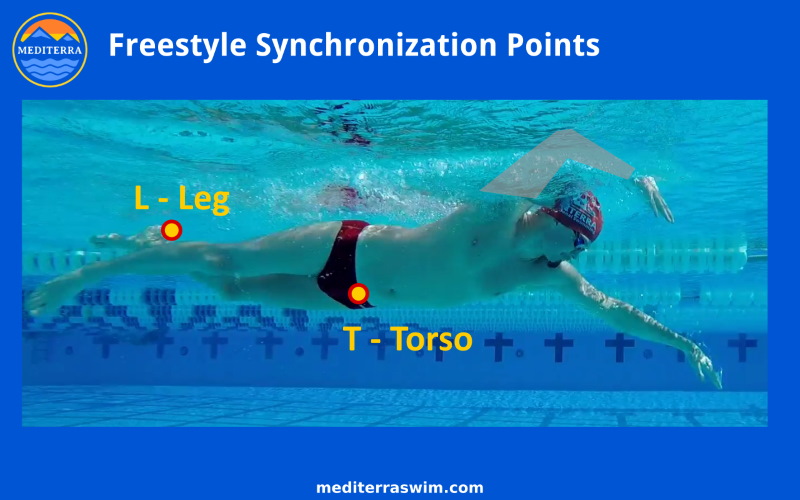
Once you have practiced the LT (leg-torso) synchronization, and the ET (entry-torso) synchronization, then it is just a blending of both of those to create the LE synchronization. However, this is moving across the body, from one extreme end to the other. It can be the most difficult connection to make, but once you do, it is the most pleasing one!
Once again, you are ‘zooming out’ to take in the full body, from foot on one side to wrist on the other, to feel the connection between these two actions, through the torso. The torso rotation empowers the entry and extension to the target. The press of the leg supports the torso rotation. Therefore, the press of the leg helps empower the extension forward.
This is often the last sync combination to practice because the other synchronization combinations are set up to support this main action of extending farther forward on each stroke. This LE synchronization is what will make your stroke as long as it can be optimally. It is what creates the acceleration you seek on every stroke. So, take the time to establish the other connections, and they will enhance this one.
Instructions
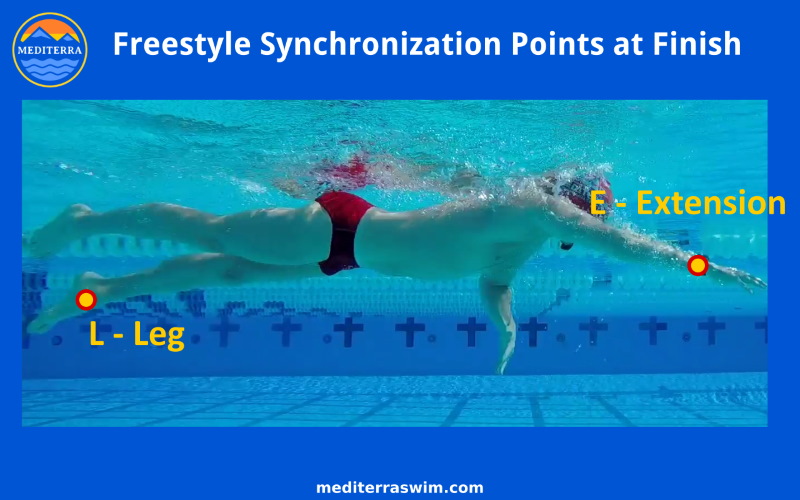
When the leg comes down to its finish position the entry arm is sliding into streamline position.
Just as you practiced pressing the leg more slowly, with a steady pressure to match the torso rotation, aim to match the pressure and rate of speed of the extension also. As noted previously, it is tempting to ‘snap’ the foot for an abrupt kick, but this sends a wave of force too quickly forward, before the extending arm is ready to absorb and apply it to extend further. Keep the press of the leg as steady and smooth, matched to the torso rotation, and thereby matched to the entry/extension. The more closely these two are matched and kept proportional in speed, the more the press of the leg can assist that extension, the more you can feel it assisting. The leg will move faster and get to its finish position before the extension finishes, but aim to make that press last longer.
There is some room to adjust the timing of the press to the tempo. At slower tempos, have the press of the leg come about half way into the entry, with the intent to use the press to help finish the extension to the target. At very fast (sprinting) tempos, it may be more helpful to have the press of the leg come right as the hand is entering in order to drive it more powerfully and more quickly to the target, since the fast tempo allows so little time to get there through the water resistance ahead.
Remember to keep all actions smooth no matter how much force is involved. You can be powerful, but in water, power must be applied smoothly, gradually building up, in order to create a more uniform (less turbulent) displacement of water molecules. Smooth actions keep drag to a minimum. As Coach Mat says sometimes, “Make the action like you are cutting butter, not like pounding meat.”
And, when you are feeling fatigued, or still have a long way to swim, this can be one of the more endurance-promoting focal points you can use. The default land-mammal reaction to fatigue is to start pulling back harder on the water. Resist this urge. Instead, put your dwindling resources into protecting this Send-Force-Forward emphasis in your stroke. Under fatigue, it will do more to reduce your loss of speed and extend your energy than just about any other emphasis.
by Admin Mediterra | Sep 24, 2020 | Synchronization
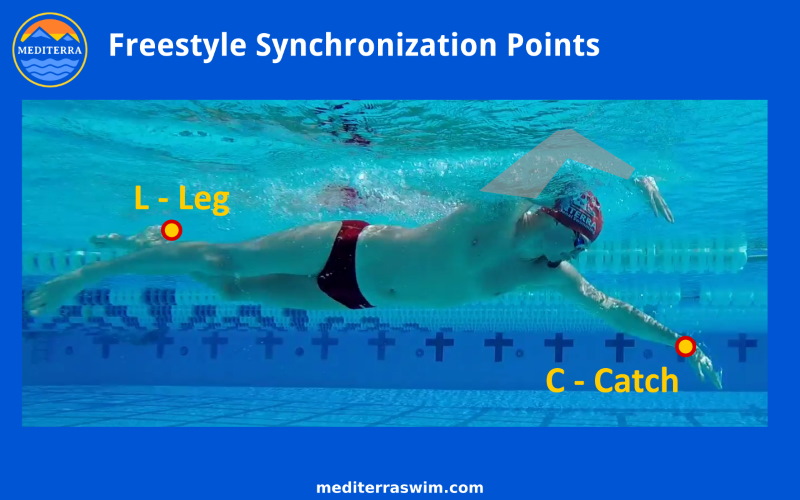
Once you have practiced the LT (leg-torso) synchronization, and the CT (catch-torso) synchronization, then it is just a blending of both of those to create the LC synchronization.
You are ‘zooming out’ to take in the full side of the body, from foot to forearm, to feel the connection between these two actions, through the torso. The torso rotation empowers the catch. The press of the leg supports the torso rotation. Therefore, the press of the leg helps empower the catch.
Instructions
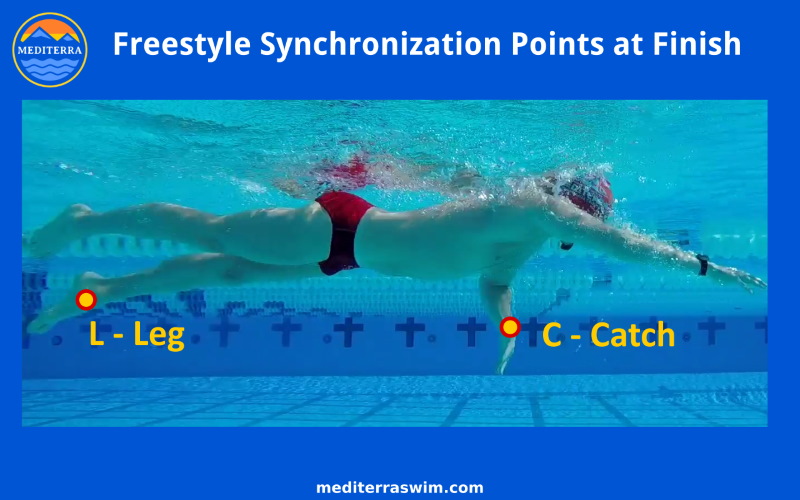
The leg will come down to its finish position as the catch is moving through its phase.
Just as you practiced pressing the leg more slowly, with a steady pressure to match the torso rotation, aim to match the pressure and rate of speed of the catch also. The more closely these two are matched and kept proportional in speed, the more the press of the leg can assist that catch, the more you can feel it assisting. The leg will move faster and get to its finish position before the catch finishes, but aim to make that press last longer.
This can be particularly useful and encouraging when you are starting to feel muscle fatigue in the catch, yet are pushing yourself to maintain steady SPL and/or tempo. Focusing on the connection between the leg and the catch can help ‘lighten the load’ on that catch action, enabling you to persist at the same effort a bit longer.
Keep a close eye on the shape and pathway of your catch so that you are maintaining your best grip on the water. The better your catch the more you will feel the press contributing toward making it easier.






